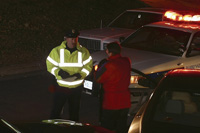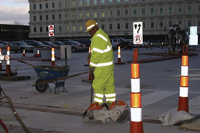|
By Mike Parson, Selling High Visibility Garments (HVGs) is a risky business. Why? Because the people who require HVGs to perform their jobs are at risk of being injured or killed if theyre not seen. Because the employers of these workers risk citations, fines, increased insurance and workman compensation claims for not properly protecting their employees. Because the dealer who provided the HVGs is at risk if the garments were not suitable for the type of work being performed. Because the manufacturer is at risk if their HVGs are self-certified but do not meet the requirements that they claim they do. Many uniform dealers and those who service customers who are exposed to moving equipment or motorized vehicles, or companies that employ personnel in these environments, know how visibility has impacted your apparel business. Its the service industrys responsibility to understand what they are selling, who they are selling to and why. Most people believe they are more visible than they truly are. They have lights on the top of their vehicles they have illuminated work areas some may choose to wave a flashlight. They may feel that these are all ways to attract attention but may in fact take away and distract the driver from the person that is in harms way. What is the overriding objective of HVGs? TO BE SEEN! Vests, jackets, pants and other garments are all forms of HVGs that are worn by law enforcement, first responders, fire fighters, airport tarmac personnel, railroad crews, rental cars companies, delivery services, construction workers and a host of other workers. The most recent figures compiled by the National Safety Council reveal that the sixth highest cause of fatal occupational injuries on the job are pedestrians struck by a vehicle or moving equipment. In most of these incidents, the drivers of the vehicles simply did not see the worker before it was too late to take safe evasive action. Obviously the tragedy of anyone being injured, maimed or killed in these accidents cannot be given a dollar valuewho can put a price on the loss of a parent, spouse or friend. However, the death or injury of a worker has a direct cost to the employer and those who supplied the HVG. There are also indirect costs, two of which include: cost of lost time to the injured employee, the foreman/supervisor or other executives assisting injured employee and the arranging for the work to done by another employee or the hiring and training of a replacement employee. The employer feels the crunch via employee welfare and benefits programs and the cost in continuing wages to an employee not able to do the tasks at the ability prior to the accident. |
|
|
 |
||
|
There is an additional area where such accidents can get very expensive. The costs of lawyers and litigation from the injured or deceaseds family. Fines and citations and the increase in insurance premiums are all additional costs that hurt the bottom line. Plus, if we add the external costs to the employer, and potentially even the dealer, these expenses grow dramatically. The external costs are where everyone is now involved, and the liability is spread across the employer, distributor and manufacturer. This is when lots of questions get asked. Did everyone do their job properly? Was the safety item issued American National Standards Institute (ANSI) compliant? Do you have the documentation to support your HVG? Additional figures compiled by the National Safety Council for direct and indirect costs of fatalities of employees in the 16-54 age group are well over $1 million per death. THE FINANCIAL IMPACT OF THE SOLUTION The price we pay for these accidents is very real. According to a recent assessment by the American Economics Group, 70 deaths and 4,500 injuries could be avoided annually with a policy requiring use of high-visibility safety apparel to be worn by all workers. A simple way to look at this is a cost-benefit ratio: For every $1 invested in high-visibility safety apparel, $5 are returned. If you include the quality of life values from which society benefits, the return would be $14 for every $1 invested in high-visibility apparel for workers. As a uniform dealer or distributor, a company should first implement a formal Visibility Safety Program. A Visibility Safety Program starts with a needs analysisa review of your customers work area environment, the exposure and risk level of the worker and visibility expectations required from motor vehicle operators. As a distributor or manufacturer of HVGs, this is the first step to making a serious commitment to the high visibility industry and the responsibilities that go with it. Choosing the proper garments based on a needs analysis that will meet your customers expected protective levels is the crucial step. Who do you trust when youre not a visibility expert? How do you know if an ANSI Compliant garment is what it says it is? EXAMPLE NEEDS ANALYSIS Step 1Familiarize yourself with the ANSI 107-1999 standard recommendations. The ANSI/ISEA 107-1999 standard provides an authoritative guideline for the proper design and performance of high visibility materials. (See sidebar p. 64). Step 2Help establish a Visibility Safety Policy and Procedure. When are the ANSI compliant HVGs to be worn and by whom? Create a regulated garment maintenance program to insure that the HVGs are reviewed by a supervisor for cleanliness or fading (even compliant garments have a limited wear-life). These garments do not last forever and will need to be replaced as part of an ongoing business. Step 3Start a training program. Teach about your visibility program in conjunction with your customers current safety meetings. Help them understand what you are asking them to wear. Explain the features and benefits of wearing HVGs properly on the job. Constant reinforcement and education helps to achieve a higher level of compliance from the work force. An early morning or dusk demonstration in a parking lot often helps convey the message better than any written warning. Step 4Build relationships with reliable manufactures or component supplier. Make sure you are dealing with people who have a full understanding of the current standards and are activity involved in the visibility safety industry. Insist on seeing certification letters and proof of compliance for all approved garments and components. Visibility and safety are a priority for both 3M and Spiewak. But comfort for the wearer plays a major role in product design and development as well. No one likes to wear garments that are uncomfortable or dont perform. Quality products designed with the wearer in mind are essential when it comes to manufacturing uniforms. The bottom line is that high visibility is critical in todays work environment and must be addressed as a serious issue. The awareness must be made from the management side as well as from the Unions and the employees themselves. Enhanced visibility for todays employees is something that is gaining support on Capitol Hill as well as to your locally run family business. It costs too much to not do anything, and it costs you even more to do something half way. REFERENCES: NAUMD – Presentation on ASI Standards, PowerPoint document link at http://www.naumd.com/safety2003.htm NSC – National Safety Council, The Burden of Occupational fatal Injury for workers in the United States Injury Insights, June/July 2002, by Daniel Harley, Ed.D., Elyce Bibble, MS., James Grosch Ph.D., and Suzanne Marsh NIOSH – National Institute for Occupational Safety & Health, Worker Health Chartbook 2000 Fatal Injury IFAI – International Fabrics Association Institute, The Unmistakable Potential of High-Visibility Apparel, by Paul Nolan ISEA – International Safety Equipment Association, Cost Benefits of PPE, from the articles Profiting from safety by Michael Warning & Dave Smith, Concrete, Construction, Sept. 2000 issue and Industrial Accident Prevention, McGraw Hill, NY U.S. Department of Labor Bureau of Labor Statistics, Fact Data: Fatal Occupational Injuries by Industry and Event or Exposure 2001 National Law Enforcement Officers Memorial, Causes of Police Deaths 1997-2001 FARSFatality Analysis Reporting System, Work Zone Fatality Statistics Calendar Year 2001 by State American Economics Group, Inc., Value of Benefits Vs. Costs for Roadway Safety Improvements, 2002 — About Spiewak: Founded in 1904, Spiewak is a fourth generation family business dedicated to providing functional, innovative protective apparel for workers and businesses. Spiewaks VizGuard, WeatherTech, Titan and Golden Fleece apparel protect major airlines, rent-a-car companies, delivery carriers, law enforcement/public safety officers, fire fighters and EMS responders around the world. About 3M: 3M is a $16 billion diversified technology company with leading positions in consumer and office; display and graphics; electronics; health care; industrial; safety, security and protection services; transportation and other businesses. Headquartered in St. Paul, Minn., the company has operations in more than 60 countries and serves customers in nearly 200 countries. For more information on 3M Scotchlite Reflective Material products, please visit the Web site at www.3M.com/Scotchlite. |
|
|
| Above story first appeared in MADE TO MEASURE Magazine, Fall & Winter 2003 issue. All rights reserved. Photos appear by special permission. | ||
| Halper Publishing Company 633 Skokie Blvd, #490 Northbrook, IL 60062 (847) 780-2900 Fax (224) 406-8850 [email protected] |
||












